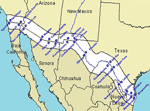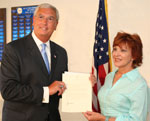U.S./Mexico Border
U.S./Mexico Border
The United States and Mexico share more than 2000 miles of common border. More than nine million people live in the border area, mostly in fifteen "sister city" pairs. The rapid increase in population and industrialization in the border cities has overwhelmed existing wastewater treatment, drinking water supply, and solid waste disposal facilities. Untreated and industrial sewage often flows north into the U.S. from Tijuana, Mexicali, and Nogales, and into the Rio Grande.
Some 300,000 people on the U.S. side of the border also lack safe drinking water, wastewater collection and treatment systems, or adequate solid waste disposal facilities. They live in unincorporated areas called "colonias." Over 1,200 colonias have been identified in Texas and New Mexico. EPA grants to the states, matched by state resources, provide for construction of wastewater and drinking water facilities in these communities. Thus far, $320 million has been appropriated by Congress for this program. Read more >
 EPA launches new border program Web site
EPA launches new border program Web site
EPA has launched a new Web site providing the public with current environmental news and information on the U.S.-Mexico Border 2012 program.
Visit the new border Web site.
EPA marks signing of final
U.S.-Mexico ‘sister city’ agreement
 EPA Administrator Stephen L. Johnson joined the mayors of El Paso, Texas; Sunland Park, New Mexico; and Ciudad Juarez, Mexico, at the signing of the final U.S.-Mexico “sister city” agreement for emergency response.
EPA Administrator Stephen L. Johnson joined the mayors of El Paso, Texas; Sunland Park, New Mexico; and Ciudad Juarez, Mexico, at the signing of the final U.S.-Mexico “sister city” agreement for emergency response.
"Healthy borders make for happy neighbors," said Administrator Johnson. "Through these Sister City agreements, we are protecting residents on both sides of the border by enhancing our ability to prevent and respond to environmental emergencies.” Read more ...>
El Paso doctor honored
with President's Volunteer Service Award
 EPA Administrator Stephen L. Johnson presented the President’s Volunteer Service Award to Dr. Elaine M. Barron of El Paso, Texas, for her outstanding work to improve public health and create a healthier environment.
EPA Administrator Stephen L. Johnson presented the President’s Volunteer Service Award to Dr. Elaine M. Barron of El Paso, Texas, for her outstanding work to improve public health and create a healthier environment.
“Today we honor Dr. Elaine Barron for answering President Bush’s call to serve a cause greater than herself,” said Administrator Johnson. Read more ...>
Matamoros project improves border environment
The first step in eliminating raw sewage discharges into the Rio Grande from Matamoros, Tamaulipas, Mexico was taken this summer by EPA and Mexican agencies when construction of wastewater Lift Station Number 1 was completed. The station is part of the $76 million first phase of a major water project that will reduce health and environmental hazards on both sides of the U.S-Mexico border.
This phase covers about a third of the city and will be completed by 2008. It includes construction of a new wastewater treatment plant, main sewage lines and four more lift stations, rehabilitation of the drinking water treatment plant, construction of raw water storage lagoons, elevated storage tanks for treated water, new pumping stations with water mains, and the installation of water meters. These measures will produce treated wastewater for agricultural irrigation, and improved drinking water quality and conservation.
The cleaner, more efficient wastewater and drinking water systems will directly benefit about 400,000 Matamoros area residents, U.S. residents in the Brownsville area and the environment down the Rio Grande. The $400 million project, providing new systems for the entire city, is scheduled for completion by 2014.
The binational Border Environment Cooperation Commission (BECC) assists with project development. Funds are administered by the North American Development Bank (NADB), a joint U.S.-Mexican organization. Mexico pays 50 percent of the project cost.
"This project is an example of improving the environment and public health through collaborative efforts by U.S. and Mexican agencies, and is an important first step in cleaning up that part of our joint border," said EPA project manager Gilbert Tellez, PhD, P.E.
For more information:
U.S./Mexico
Border Program
U.S./Mexico Border Environmental Program: Border 2012
Border 2012 is a 10-year, binational, results-oriented environmental program for the U.S.-Mexico border region. The Border 2012 Program is the latest multi-year, binational planning effort to be implemented under the La Paz Agreement and succeeds Border XXI, a five-year program that ended in 2000. Read more >
The Good Neighbor Environmental Board
 The
Good Neighbor Environmental Board is an independent federal
advisory committee. Its mission is to advise the President
and Congress of the United States on good neighbor practices
along the U.S. border with Mexico. Its recommendations are
focused on environmental infrastructure needs within the U.S.
states contiguous to Mexico. Good Neighbor does not carry
out any specific border program. Rather its role is to step
back as an expert, concerned observer and analyze the big
picture when it comes to the problems the border region faces,
as well as the opportunities at hand. Read
more >
The
Good Neighbor Environmental Board is an independent federal
advisory committee. Its mission is to advise the President
and Congress of the United States on good neighbor practices
along the U.S. border with Mexico. Its recommendations are
focused on environmental infrastructure needs within the U.S.
states contiguous to Mexico. Good Neighbor does not carry
out any specific border program. Rather its role is to step
back as an expert, concerned observer and analyze the big
picture when it comes to the problems the border region faces,
as well as the opportunities at hand. Read
more >
American Heritage Rivers
 The
heart of the American Heritage Rivers initiative is locally
driven and designed solutions. The federal role is confined
to fostering community empowerment, while providing focused
attention and resources to help river communities restore their
environment, revitalize their economy, renew their culture and
preserve their history. Read
more >
The
heart of the American Heritage Rivers initiative is locally
driven and designed solutions. The federal role is confined
to fostering community empowerment, while providing focused
attention and resources to help river communities restore their
environment, revitalize their economy, renew their culture and
preserve their history. Read
more >
American Heritage Rivers Keystone Project
Rio Grande River: an American Heritage Designated River
EPA Administrator Visits Pueblo Cultural Center and River Restoration Project
In support of National American Indian Heritage Month in November and water quality improvement, EPA Administrator Mike Leavitt visited the Pueblo Cultural Center and the Rio Grande Riparian Restoration Project in Albuquerque, N.M. Sandia Pueblo, the New Mexico Environment Department, EPA and others are working together to restore approximately 100 acres of riparian and wetland habitat along the Rio Grande. Read more >
Status Report on the Water and Wastewater Infrastructure Program for the U.S./Mexico Border
In the Mexican Border region, pollutants from both countries are entering shared waterways due to inadequately treated sewage. This, along with inadequately treated drinking water, is impacting the health of border residents as well as degrading environmental quality. The United States and Mexico have developed a cooperative program along the international boundary to address these issues. Read more >

Resources
- Region 6 Public Information Center (800) 887-6063
- About Region 6
- Federal Register
- Contact Us
- Freedom of Information Act
- Employee Access
Additional Information
Air, Agriculture, Brownfields, Cleanup, Ecosystems, Enforcement, Environmental Justice, Grants, Laboratory, Pesticides, Superfund, Tribal, Training, Waste, Water, more topics
![[logo] US EPA](https://webarchive.library.unt.edu/eot2008/20080916222323im_/http://www.epa.gov/epafiles/images/logo_epaseal.gif)